If you’re used to crocheting with yarn on an aluminum crochet hook, working smaller—with, say, size 80 tatting thread on a size 14 (0.60 mm) steel hook—presents a challenge. Basic crochet mechanics and matters of proportion add to that challenge. All crochet hooks have a cone-shaped section that extends to a cylinder; by pushing the yarn back to this cylinder every time you form a loop, you can maintain uniform stitches and an even gauge—at least with coarser yarns.
Crocheting worsted-weight yarn on a size G (4.00 mm) hook creates loops with just enough room for the yarn to slip through smoothly, thanks to that cylinder. If you try this with size 80 tatting thread on a size 14 (0.60 mm) hook, however, your loops, although consistent in size, will be huge compared with the thickness of the thread. Stitches formed like this will not show your pattern to advantage, particularly if it’s a lace pattern that is supposed to be light and airy.

Crocheting with painter’s tape wrapped around a size 14 hook. Photo by Philip Chien
I set out to find a way to form consistent yet smaller loops by stopping each one at exactly the same spot along the cone before it could reach the cylinder. I thought of marking the spot with a permanent marker pen but didn’t want to mark up my hook. I was considering masking tape when my friend Philip Chien suggested that I use painter’s tape, a blue wonder that rips and sticks more easily than masking tape and leaves no residue. It’s readily available in the painting supplies section of hardware and discount department stores.
After experimenting with stopping my stitches at various points on the cone, I concluded that the stitches formed at a distance of 5⁄8 inch (1.6 cm) from the hook looked best. By wrapping that point with a piece of tape 2 inches (5.1 cm) long, I created a raised lump to stop my loops, ensuring that every stitch would be consistent and of the size that I wanted.
You’ll need to adjust the placement of your tape according to the thread and crochet hook that you will be using for a given project. And you’ll want to practice crocheting with the tape in place for about 15 minutes before you start your project. You may find, as I have, that this trick also makes using a magnifier optional rather than a necessity.
Interested in more ways to improve your crochet skills? This article and more can be found in the May/June 2010 issue of PieceWork.
Also, remember that if you are an active subscriber to PieceWork magazine, you have unlimited access to previous issues, including May/June 2010. See our help center for the step-by-step process on how to access them.
Terri Wells has been a crafter for most of her life and a writer for almost as long.
Originally published October 16, 2020; updated May 29, 2023.

